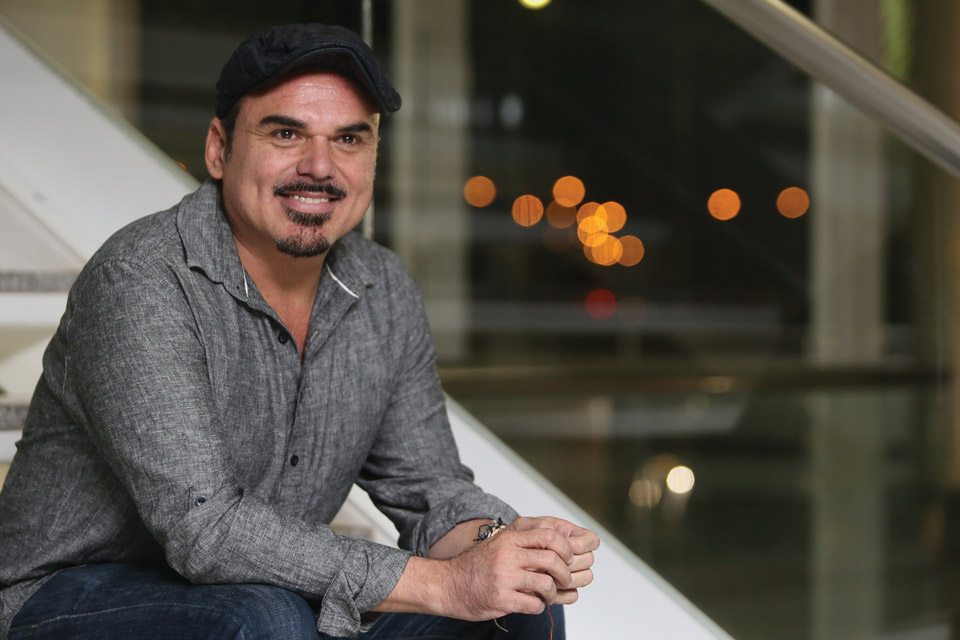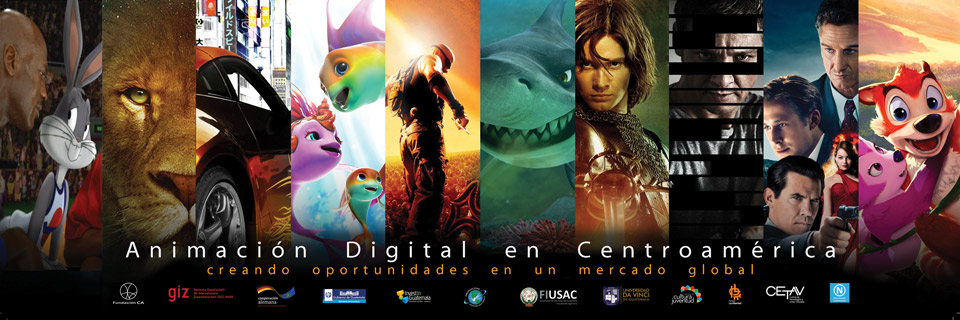Carlos Argüello
Visualizing a Digital Future for Latin America
PROFILE by Linda Conard.
Carlos Argüello—the Oscar-nominated mastermind behind unforgettable visual effects in Hollywood blockbusters like “The Chronicles of Narnia,” “Batman and Robin,” “The Devil’s Advocate,” “The Mummy” and “Armageddon,” and groundbreaking music videos for artists like Michael Jackson and David Byrne—has created never-imagined new worlds on the silver screen. Now he’s using that same digital technology to explode preconceptions of Latin American youth and create new futures in Guatemala and beyond.
Argüello’s latest production isn’t a film or a video—it’s a breakthrough foundation that trains designers aged 18-24 in digital animation techniques, and attracts visual imaging jobs to the region as “insertion” points, where these designers can practice their skills and build rewarding careers. This year, Fundación C.A. will embark on a three-year program to train 900 young designers in Guatemala, El Salvador and Costa Rica.
Although Argüello is now known as both a creative and social visionary, his “vision” once led teachers to tell his mother, “Carlos is not college material.” He struggled with undiagnosed acute dyslexia as a child in Guatemala. “Drawing was the only thing I liked,” he says. At age 17, he realized he would have virtually no opportunities. Although he spoke little English, headed north to California to live with his aunt.
In San Francisco, Argüello went from “not college material” to studying at the Academy of Art University while waiting tables to pay tuition. “The cool thing about that art school was that they had computers,” he says. “I touched a computer for the first time and I thought, ‘OK, this is what I want to do.’”
That love of computers motivated him to apply for an internship with Synthetic Video to create 3-D models for Ford Aerospace/NASA. “An internship meant no pay, but I didn’t care. I knew they would have computers there—big ones where you can do images and stuff,” he says. When the selection committee chose him from a pool of more than 60 highly qualified applicants, he thought there must be a mistake. Four years later, after he’d become creative director and part owner of the company, he finally asked a colleague why they’d chosen him. “They said my work looked nice, but what really impressed them was my passion in describing my work,” Argüello says. Today, he shares that story to inspire student groups in talks throughout Latin America. “It’s important that they know that sometimes it’s the passion in your work that says it all.”
Argüello later became the creative director for Pacific Data Images (now DreamWorks), where he and his staff created the groundbreaking effects for music videos like Michael Jackson’s “Black or White,” and movies like “Natural Born Killers.” Eventually, he moved to Cinesite and then to Disney, directing visual effects for films like “Armageddon,” “Waterworld,” “Free Willy” and “Space Jam.”
Then, after nearly 20 years of creating digital magic, he pulled the plug.
Argüello sold his California home, moved to the tranquil seclusion of La Antigua Guatemala, and put the movie industry far behind him. Or, so he thought. Within just three years, a chance conversation in Antigua’s Parque Central plunged him back into the world of visual effects.
“I was sitting on a bench talking to this kid—he said he was a carpenter—and when I asked him his dreams, he told me he would probably just live his whole life as a carpenter in Antigua because there are no opportunities,” Argüello recalls. Watching hundreds of school kids in uniforms swarming into the park, he realized that, like the young carpenter, these kids faced the same limitations he’d faced at their age—and the problem had grown.
“I thought, ‘What can I do? I just do technology and entertainment, and there’s no technology or entertainment in Antigua. I can’t help,’” he says.
But, the idea of those kids with little opportunity ahead haunted him. He explains, “There’s this phrase that I love: ‘If not me, who? If not now, when?’ So I thought, if there’s no technology here, then let’s bring it here.”
That idea grew into Studio C, where young Guatemalans produce special effects for movies, television and educational programs. Studio C is the only studio in Latin America that has worked with the largest Hollywood studios in the industry. It started with just three local young men from Antigua: two computer fanatics, Marvin Barillas and Nelo Mijangos, and their friend Ludwing Paniagua. “[Marvin and Nelo] told me that Ludwin loved to paint, but had never touched a computer. So I said, ‘We’ll teach him!’” Later, Ludwin went on to create the lion’s castle featured in “The Chronicles of Narnia.”
The principle “we’ll teach them” is the beating heart of Studio C. From three Antigua friends, the studio grew to 30 artists ages 18-26, then moved to the capital to accommodate up to 100 designers. None of these new designers had previous training in the digital world. “You just had to have passion and interest, and like technology,” says Argüello.
Studio C worked on small, local projects until Argüello landed the opportunity for them to create a helium world for the 2004 sci-fi thriller, “The Chronicles of Riddick.” “This was the first film that basically proved we could work long-distance—that the kids here in Guatemala were ready for it,” he says.
One year later, a very different “Chronicles” film would prove just how ready the Studio C designers really were. In 2005, Argüello sought a role for Studio C in “The Chronicles of Narnia,” which would soon enter production. The producers had already assigned the film’s special effects to larger studios, but invited Studio C to produce the trailer. The trailer so impressed the producers that they asked Studio C to design the lion’s castle for the feature film, plus 370 additional effects, earning Studio C an Academy Award nomination for Best Visual Effects. “The kids didn’t even know what an Oscar was … but they realized it was something big when they were invited to be on CNN,” says Argüello.
Despite its success, Studio C received minimal support from the Guatemalan government and others, making it difficult to attract big projects. So, Argüello created Fundación C.A., the social arm of Studio C. He fought hard to convince potential supporters that training Latin American youth could work. Even members of the United Nations in Geneva balked at the idea, according to Argüello. “They said, ‘Are you sure that Latin America is ready? Are the kids really going to take to computers the way you say they are?’”
The work of Fundación C.A.’s new designers left no room for doubt. In 2007, 200 young digital artists began training in Mexico and then joined forces with the Guatemala team for the second “Narnia” film, “Prince Caspian.” “It was really cool to see kids from Mexico and Guatemala collaborating,” says Argüello.
Now Fundación C.A. offers programs in Mexico, Colombia, Guatemala, El Salvador and Costa Rica, and will soon begin working in Brazil and the Dominican Republic. In addition to the ambitious goal of training 900 designers in three years, Argüello is launching six training centers in six municipalities around Guatemala City, plus a job insertion center near the capital offering paid internships.
Although its work on Hollywood megaproductions receives the most attention, Fundación C.A. emphasizes education and cultural preservation. Its young designers have created virtual maps, interactive mathematics games developed with Microsoft, programs for students with learning disabilities, and educational programs in numerous Mayan languages.
The foundation has won multiple international awards for educational programs, including the World Summit Award for its Guatemala Interactive Project covering 3,000 years of Guatemalan history.
Computer visualization will only grow more critical to the new industries coming into Latin America, such as engineering and aerospace design, according to Argüello.
“Basically, we’re teaching a new language for the youth of Latin America to be able to get involved in the world market,” he says. “I had learning disabilities, and I’ve known kids who come from small homes with no floor, but they touch a computer and work with us and do great things. … Everything is possible in Guatemala; everything can be done from Guatemala. We have talent and we basically need to invest in that talent, which is youth.”



Muy buen articulo, waw, espero poder compartir con todos, es justamente la oportunidad que estaba buscando, y veo la necesidad de mi pais, es un buen comienzo. Como puedo contactarme con la fundacion, en mi comunidad hay chicos que quieren hacer esto. Gracias por compartir el articulo, fuerzas…
Arguello magnificently expands his enormous vision and talent globally, as he did as a student at the Academy of Art University in San Fransico, in the “Barking Fish” Fine Art Printing Studio! Cheers to continued grandeur and success.